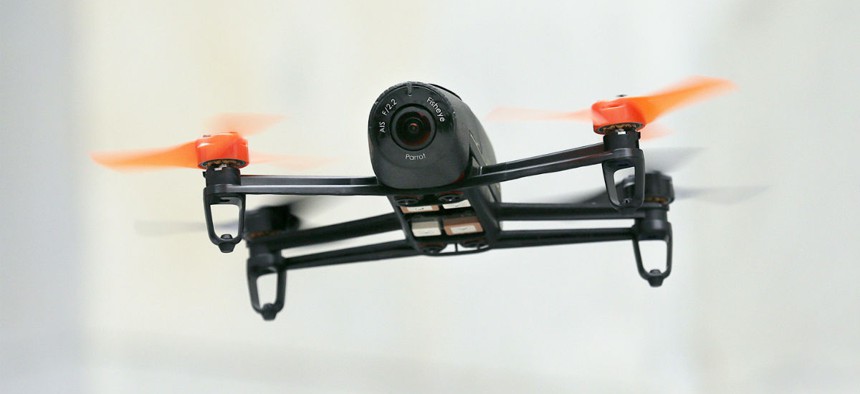Vetoed Drone Legislation the Right Step for Growing Industry

A Parrot Bebop drone flies during a demonstration event in San Francisco. Jeff Chiu/AP File Photo
Drones may represent the ultimate in disruptive technology.
Gary Shapiro is president and CEO of the Consumer Electronics Association and author of “Ninja Innovation: The Ten Killer Strategies of the World's Most Successful Businesses” and “The Comeback: How Innovation Will Restore the American Dream.” His views are his own. Connect with him on Twitter: @GaryShapiro. Brian Wynne is president and CEO of the Association for Unmanned Vehicle Systems International, the largest association representing the unmanned systems and robotics industries. Connect with him on Twitter: @BWynne.
Commercial drones -- also called unmanned aircraft systems -- offer an amazing and ever-increasing array of beneficial applications. They can deliver prescription drugs, help in search-and-rescue efforts and aid disaster-relief missions.
Yet, flying in the face of innovation and opportunity, some states are trying to ground or prematurely restrict this life-changing technology. On Sept. 9, California Gov. Jerry Brown wisely vetoed a bill that would have outlawed flying drones below an arbitrary altitude over private property without permission. While the UAS industry supports the safe, nonintrusive use of drones, Senate Bill 142 would have taken a wrong and damaging approach.
Brown recognized the concerns expressed by a broad coalition of private and commercial users, manufacturers and retailers of UAS. While we agree that issues of privacy as it relates to drones need to be addressed, SB 142 was the wrong approach. In fact, a national initiative on drone-related privacy issues led by the U.S. National Telecommunications and Information Administration began this summer and includes a wide range of public and private sector stakeholders.
The recent measure didn’t provide any commercial, research or educational exemptions. That was a serious concern that went well beyond California’s borders, as major companies are poised to invest billions in this technology and provide exciting new services to consumers. And the bill’s 350-foot flight limit was a purely arbitrary ceiling that didn’t recognize the realities of UAS operation.
As a result, the measure could well have led to litigation against drone users and thwarted a growing and innovative industry -- one that’s poised to deliver roughly 18,000 new jobs to California and more than $14 billion in economic impact in the state over the next 10 years. Ill-considered measures, such as the one Brown correctly vetoed, could drive jobs and innovation over the border and overseas.
Drones may represent the ultimate in disruptive technology. At the first international Drones for Good competition earlier this year, Swiss company Flyability took home a $1 million research grant for its work on Gimball, a drone protected by a rotating cage that enables it to navigate small spaces and survive collisions with other objects without losing its stability — critical in hard-to-navigate rescue zones.
Examples abound of innovative drone uses that reduce environmental impact, provide support in emergencies and streamline productivity. The Swiss postal service is testing mail delivery by drones, a service that could offer one-day delivery of timely laboratory-test results to doctors. Also, farmers are interested in using drones to survey crops and identify problem spots to help reduce water and pesticide use.
Other life-saving benefits of drones are far more literal. In Wisconsin, an 82-year-old man who was missing for three days was found in 20 minutes when David Lesh heard the story and deployed his drone. A drone successfully delivered medical supplies to a rural health clinic southwestern Virginia. And Motorola recently announced it’s partnering with CyPhy, a leader in tethered UAS that can stay in the air indefinitely and provide support in first-responder situations.
The Federal Aviation Administration and other stakeholders need to weigh the benefits of improved technology and more innovation against privacy and safety concerns. Our associations are promoting and supporting consumers’ responsible drone use through the Know Before You Fly campaign, which warns consumers against potentially dangerous activities, such as flying above a predetermined flight ceiling or near airports and sports stadiums.
The associations we represent look forward to a balanced and thoughtful UAS policy framework from the federal government and the stakeholder groups.
We recognize the temptation of local lawmakers to move first and impose requirements around this new technology. That’s why the FAA needs to complete its job and finalize rules on flying UAS, as mandated by Congress. Only the FAA can regulate airspace; states and municipalities cannot. It’s critical for the federal government to assert its preemption authority and clarify this matter.
With UAS, as with other innovative technology, we must avoid a patchwork of local laws thwarting the life-changing benefits drones offer us -- faster delivery of supplies after disasters, lower fuel consumption and carbon emissions, and more efficient crop production.
We benefit enormously from innovation, but its path to the marketplace is often unpredictable. Policymakers may influence how products are made and sold, but we see companies are already regulating themselves with a focus on safety, security and reliability.
When they don’t, the public holds them accountable. Only then should the government step in. And when the government does step in, it should do so comprehensively -- as a partner focused on creating a business and regulatory environment where life-changing innovation is encouraged, not grounded.





